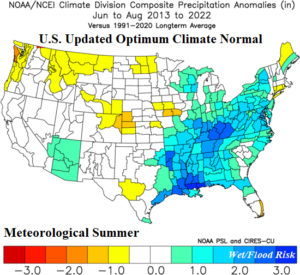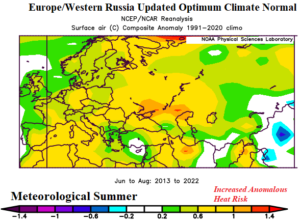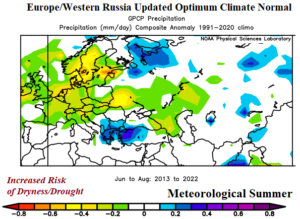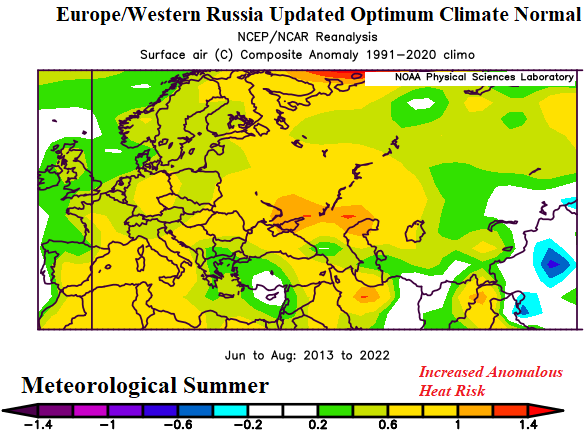Warm and Cool Regional SSTA and Their Correlation to “Ridiculously Resilient Ridge (and Trough)” Locations
05/10/2023, 8:29 am EDTClimate/Agriculture Research: Status of Global Marine Heat Waves (and Warm Holes)
05/29/2023, 9:06 am EDT

Fig. 1-2: U.S. temperature and precipitation anomalies based on the adjusted (2013-2022) optimum climate normal.


Fig. 3-4: Europe and Western Russia temperature and precipitation anomalies based on the adjusted (2013-2022) optimum climate normal.
Discussion: Applied to all climate forecasts is recent historical patterns due to their significant difference from a standard 30-year climatology and driven (mostly) by accelerated ocean surface warming of recent years.
Specifically, emergence of a semi-permanent marine heat wave (MHW) in the northeast quadrant of the North Pacific Ocean and similar but opposite (cool) sea surface temperature anomaly regime south of Greenland known as the North Atlantic warm hole (NAWH). The MHW in the Northeast Pacific is caused by anomalous high pressure leading to more warming sunlight while the NAWH pattern is driven by accelerated cold fresh water melt from the Greenland ice sheet creating a stratified layer of ocean cooling in an otherwise warmer than normal North Atlantic.
The semi-permanent regional SSTA patterns are causing the North America and Europe climate to change. During meteorological summer, which is almost upon us, the U.S. has a tendency for anomalous heat across the western half of the nation plus the East Coast with near normal temperature centered on the Mid-south States (Fig. 1). The hottest anomalies are in the Far West which has observed hostile drought for most of the past 10 years.
The weakness in the upper atmosphere suppressing heat in the Mid-south States inspires a moisture channel out of the Gulf of Mexico causing a wet climate change for much of the East (Fig. 2) while the warm western North Atlantic causes stronger high-pressure just offshore and the return southwest flow keeps summertime hotter than normal in the East.
In Europe and Western Russia, the summertime climate has changed and favors a substantial increase in hotter than normal risk everywhere (Fig. 3) due to increased high pressure aloft compensating for the semi-permanent upper trough residing over the NAWH south and east of Greenland. The hottest risk is in the Black Sea region and Southwest Russia. The increased high pressure aloft also supports a drier climate for most of Europe nowadays during the summer season (Fig. 4). The (wet) exception is Northwest Russia.

